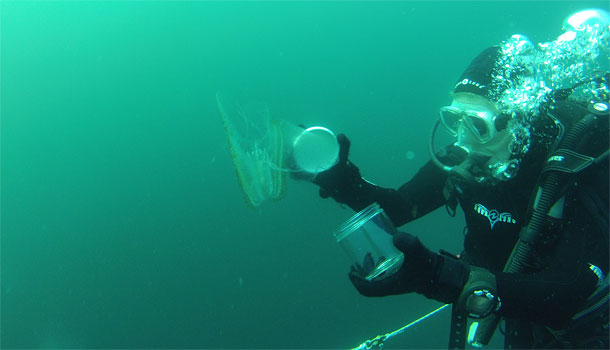
Meghan L. Powers
Ocean Sciences
Santa Cruz
Question:
What is bioluminescence?
Answer:
Bioluminescence is simply light produced by a living organism, plant or animal. Within the organisms' cells are molecules that produce this chemical reaction. Sometimes, bioluminescence is confused with fluorescence. The difference is that fluorescence requires an external light source to emit light, whereas bioluminescence does not. I'm interested in the genes of bioluminescent marine organisms to better understand how bioluminescence has evolved in the ocean.
Question:
What do you look for?
Answer:
When our lab goes on sampling expeditions aboard research vessels, I'm looking for comb jellies and other zooplankton that have unique bioluminescent activity. Once we collect an interesting sample, I use molecular techniques to obtain genetic information from the organism. Then, I look through this data for genes that produce the bioluminescent protein.
Question:
Why are comb jellies so interesting?
Answer:
Comb jellies, or ctenophores, are beautiful animals that live throughout the world’s oceans and even in a few lakes. They acquired this name from their 'combs,' which are rows of cilia they use to swim. They are the largest animal to use cilia for locomotion. Almost all ctenophores are bioluminescent and generally emit blue to green light, which is one reason I'm interested in these animals. Ctenophores also occupy an interesting place at the base of the animal tree of life. They are important to understanding the early evolution of animals and how complexity has evolved.
Question:
How might this research benefit us?
Answer:
The idea behind this research was to discover new bioluminescent molecules that could be engineered and used to illuminate cells of interest in biomedical research. There are some bioluminescence molecules already used for this purpose. However, there are so many different types of luminescent systems and chemistry in the ocean, we are hoping they will provide more useful applications for this field.
Question:
What's it like working on a ship?
Answer:
I have spent a lot of time aboard many research vessels. I've even spent an entire month aboard a boat in the Southern Ocean off the coast of the Antarctic Peninsula, which was an amazing experience. Most of my time at sea has been aboard the "R/V Western Flyer," which is operated by the Monterey Bay Aquarium Research Institute. On our cruises, we use remotely operated vehicles (ROVs) to collect samples as deep as 3,500 meters below the surface. We also scuba dive and use large net tows to collect samples as well. Doing science on a boat is not without certain challenges, but I still get excited every time I go to sea. We get to explore an environment that not many people get to experience and scientists are still learning about many of the organisms that live there.
Question:
Have you always been fascinated by the ocean?
Answer:
I've always been interested in ocean research, even as a young kid. For a fourth-grade science project, I made a model of the ocean floor in clay that was too heavy to move. i went to science camp in the summers and loved biology in high school. I think I was really lucky to have science teachers who encouraged me to pursue science, and I went on to study biology at UC Santa Barbara. Once there, I participated in a summer research program and I was hooked. I realized I loved to approach questions in marine biology using molecular techniques. It is still what I do today, working on bioluminescence. I mean, how can you not find luminescent jellies fascinating.
Question:
Do you ever get seasick?
Answer:
I still get seasick from time to time. I take medication to try to combat this horrible affliction, but sometimes it's inevitable. Especially when the weather is bad, which can be often, depending on which ocean you’re in and the time of year. Luckily, I love what I do and that helps to power through the rough patches.